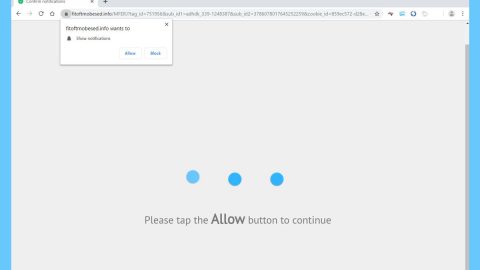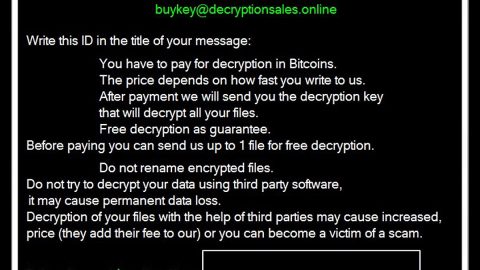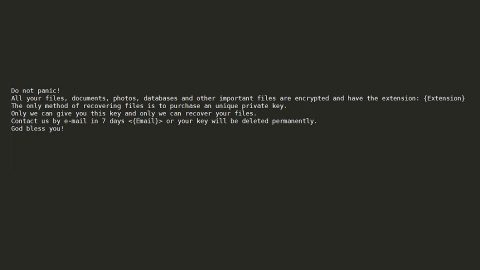What is CryptoLocker ransomware? And how does it execute its attack?
CryptoLocker ransomware is a new version of a crypto-malware that was first discovered way back in 2013. Back then, CryptoLocker spreads using the Gameover Zeus botnet and even though the malware was quickly shut down by security experts, new versions of this threat just keep on emerging.
The moment CryptoLocker ransomware infiltrates a system it will scan the entire drive of the infected system and scan for several file types such as:
3fr, accdb, ai, arw, bay, cdr, cer, cr2, crt, crw, dbf, dcr, der, dng, doc, docm, docx, dwg, dxf, dxg, eps, erf, indd, jpe, jpg, kdc, mdb, mdf, mef, mrw, nef, nrw, odb, odm, odp, ods, odt, orf, p12, p7b, p7c, pdd, pef, pem, pfx, ppt, pptm, pptx, psd, pst, ptx, r3d, raf, raw, rtf, rw2, rwl, srf, srw, wb2, wpd, wps, xlk, xls, xlsb, xlsm, xlsx.
As you can notice, CryptoLocker ransomware targets various files. These targeted files are encrypted using the RSA encryption algorithm. Once the encryption is done, all these file types will be inaccessible. The malware then displays a ransom note that states:
“Your personal files are encrypted!
Your important files encryption produced on this computer: photos, videos, documents, etc. Here is a complete list of encrypted files, and you can personally verify this.
Encryption was produced using a unique public key RSA-2048 generated for this computer. To decrypt files you need to obtain the private key.
The single copy of the private key, which will allow you to decrypt the files, located on a secret server on the Internet; the server will destroy the key after a time specified in this window. After that, nobody and never will be able to restore files…
To obtain the private key for this computer, which will automatically decrypt files, you need to pay [specified amount of money in EUR or USD] similar amount in another currency.
Click To select the method of payment and the currency.
Any attempt to remove or damage this software will lead to the immediate destruction of the private key by a server.”
If you’re the kind of a user that keeps backup copies of important files, then CryptoLocker shouldn’t scare so there is no need for you to pay the ransom or use recovery software. However, if you only have one copy of your important files, then you’ll have a big problem. Worry not, since there are other recovery methods you can try to decrypt the affected files. And besides paying the ransom is not recommended as cybercrooks can’t be trusted and there is also no assurance that once you pay the ransom, the sly crooks will give you the decryption key. The best thing you can do is to eliminate the malware from your system first then try to recover the encrypted files.
How does CryptoLocker ransomware disseminate its malicious payload?
According to security experts, this new CryptoLocker ransomware spreads using spam emails, fake pop-ups and other similar techniques – because of its use of old and new distribution methods, this crypto-malware has managed to infect a lot of users.
Eliminate CryptoLocker ransomware by following the given steps below.
Step 1: Tap the Ctrl + Alt + Delete keys to open a menu and then expand the Shutdown options which is right next to the power button.
Step 2: After that, tap and hold the Shift key and then click on Restart.
Step 3: And in the Troubleshoot menu that opens, click on the Advanced options and then go to the Startup settings.
Step 4: Click on Restart and tap F4 to select Safe Mode or tap F5 to select Safe Mode with Networking.
Step 5: After your PC has successfully rebooted, tap Ctrl + Shift + Esc to open the Task Manager.

Step 6: Go to the Processes tab and look for CryptoLocker.exe and other suspicious-looking processes that take up most of your CPU power then end all of its processes.

Step 7: Exit the Task Manager and open Control Panel by pressing the Windows key + R, then type in appwiz.cpl and then click OK or press Enter.

Step 8: Look CryptoLocker Ransomware or CryptoLocker.exe and then uninstall it.

Step 9: Close Control Panel and tap Win + E keys to open File Explorer.
Step 10: Navigate to the following locations and look for CryptoLocker ransomware’s installer named as CryptoLocker.exe and other related files and delete them all.
- %TEMP%
- %APPDATA%
- %APPDATA%\Microsoft\Windows\Start Menu\Programs\Startup\
- %USERPROFILE%\Downloads
- %USERPROFILE%\Desktop
Step 11: Close the File Explorer.
Before you proceed to the next steps below, make sure that you are tech savvy enough to the point where you know exactly how to use and navigate your computer’s Registry. Keep in mind that any changes you make will highly impact your computer. To save you the trouble and time, you can just use PC Cleaner Pro, this system tool is proven to be safe and excellent enough that hackers won’t be able to hack into it. But if you can manage Windows Registry well, then, by all means, go on to the next steps.
Step 12: Tap Win + R to open Run and then type in regedit in the field and tap enter to pull up Windows Registry.

Step 13: Navigate to the listed paths below and look for the registry keys and sub-keys created by CryptoLocker ransomware.
HKEY_LOCAL_MACHINE\Software\Microsoft\Windows\CurrentVersion
Step 14: Delete the registry keys and sub-keys created by CryptoLocker ransomware.
Step 15: Close the Registry Editor and empty your Recycle Bin.
Try to recover your encrypted files using their Shadow Volume copies
Restoring your encrypted files using Windows’ Previous Versions feature will only be effective if ACCDFISA v2.0 hasn’t deleted the shadow copies of your files. But still, this is one of the best and free methods there is, so it’s definitely worth a shot.
To restore the encrypted file, right-click on it and select Properties, a new window will pop-up, then proceed to Previous Versions. It will load the file’s previous version before it was modified. After it loads, select any of the previous versions displayed on the list like the one in the illustration below. And then click the Restore button.

To make sure that CryptoLocker ransomware is completely removed and that nothing is left behind, use the following antivirus program. To use it, refer to the instructions below.
Perform a full system scan using SpyRemover Pro. To do so, follow these steps:
- Turn on your computer. If it’s already on, you have to reboot
- After that, the BIOS screen will be displayed, but if Windows pops up instead, reboot your computer and try again. Once you’re on the BIOS screen, repeat pressing F8, by doing so the Advanced Option shows up.
- To navigate the Advanced Option use the arrow keys and select Safe Mode with Networking then hit
- Windows will now load the SafeMode with Networking.
- Press and hold both R key and Windows key.
- If done correctly, the Windows Run Box will show up.
- Type in explorer http://www.fixmypcfree.com/install/spyremoverpro
A single space must be in between explorer and http. Click OK.
- A dialog box will be displayed by Internet Explorer. Click Run to begin downloading the program. The installation will start automatically once a download is done.
- Click OK to launch it.
- Run SpyRemover Pro and perform a full system scan.
- After all the infections are identified, click REMOVE ALL.
- Register the program to protect your computer from future threats.
















